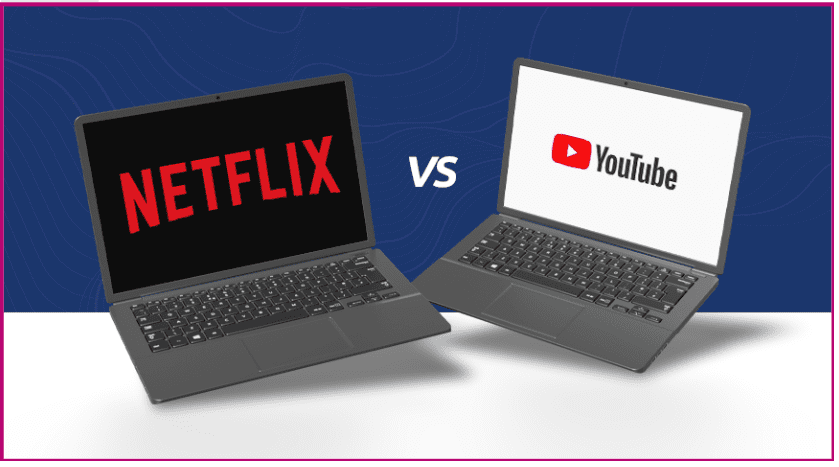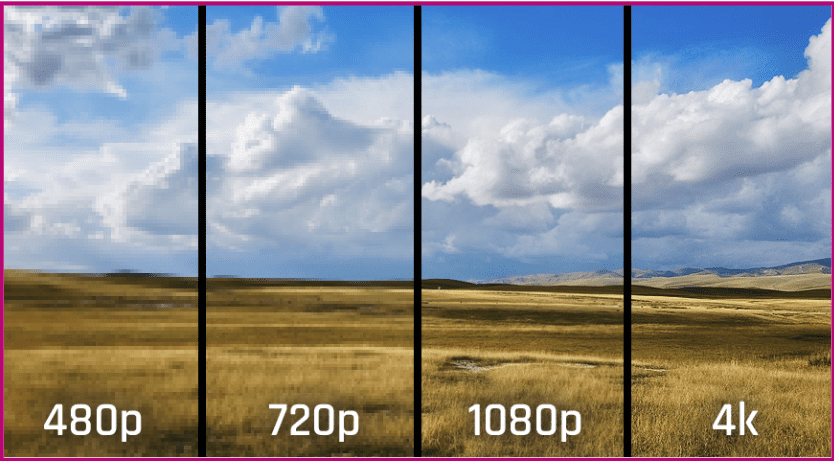Did you know: over 98% of Canadians use YouTube? (Comscore, 2023).
YouTube is one of the most visited sites on the entire World Wide Web, second only to Google (SEMrush, 2024). Whether you enjoy cooking videos, DIY tutorials, or have children who can’t get enough of Ms. Rachel, chances are good that you use YouTube on a regular basis.

The ability to have YouTube tutorials and entertainment at our fingertips comes at a cost – specifically, your data plan. But exactly how much of your data is getting eaten up by your video streaming habit?
Our wireless network team gathered YouTube data stats by averaging consumption habits to figure out how much data YouTube uses. Spoiler: video streaming in HD uses a lot of data.
If you want to know exactly how much data YouTube uses, or learn how to reduce your data usage while still enjoying your favourite video content, read on! We’ve answered all of your questions and more in this blog post.
How Much Data YouTube Uses
So, let’s begin by addressing the reason you’re here: How much data does YouTube use? We’ve averaged streaming consumption and cross-referenced our data with other trusted sources to come up with the ranges below.
| Video Resolution | 1 Hour of Viewing* | 2 Hours of Viewing* | Type of Content | Average Data Usage (per hour)* |
| 144p | 48-88 MB | 116-156 MB | Music Videos | 68 MB |
| 360p | 350 – 400 MB | 700 – 800 MB | Standard Definition | 375 MB |
| 720p (HD) | 1 – 1.2 GB | 2 – 2.4 GB | High Definition | 1.1 GB |
| 1080p (Full HD) | 2.5 – 3 GB | 5 – 6 GB | Full High Definition | 2.7 GB |
| 4K (2160p) | 5.5 – 8 GB | 11 – 16 GB | Ultra High Definition | 6.7 GB |
*Please note: these ranges are approximations, and your experience may vary.
The ranges in usage in the table above are mainly due to YouTube’s variable bitrate. We’ll explain that further in the next section.
YouTube Data Use by Streaming Quality
At this point, you may be wondering: why does better-quality video eat away at more of your data? The answer lies in two factors: resolution and bitrate.
Resolution is the number of pixels displayed on your screen. When you see a number like “1080p”, this means that there are 1,080 pixels that make up the video image. The more pixels on your screen, the sharper the image, and the higher the definition.
Bitrate is the amount of data processed per second. The higher the bitrate, the smoother the movement on the screen, and the better clarity of the video. Bitrate is highly variable on YouTube – this is why there is such a high range in the data usage approximations above.
Both of these factors include additional data transfers to your device to either make a sharper picture or process movement quicker. This additional data requirement is the reason for the extra usage.
YouTube Data Use by Video Pixel Size
Now that you have an understanding of how much data you’re using on YouTube, and where this data is being used, let’s get into what this means for your video streaming habits.
| Video Resolution | Video quality | Ideal for: |
| 144p | Lowest acceptable video quality | Viewers with very limited data plans, poor wi-fi or data connectivity, or those watching on small screens. |
| 360p | Standard definition | Users who want to strike a balance between moderate video quality and reasonable data usage. Ideal for mobile use. |
| 720p (HD) | High definition entry point | Users who want higher than standard definition, but don’t need full high definition. Great for shows and movies. |
| 1080p (Full HD) | Full high definition | Users who want a sharp, detailed image for a greatly enhanced viewing experience and don’t mind the extra data consumption. Great for sports, nature documentaries, and more. |
| 4K (2160p) | Ultra high definition | Users who want an ultimate viewing experience and have an unlimited data plan. This resolution means crystal-clear, sharp images and smooth on-screen motion. Users without a strong connection can experience long buffering delays. |
Although 4K may sound like the best option, it has its drawbacks. 4K devours data at an alarming rate, and if you’re watching on a device like a phone, you may not notice the added pixels.
Additionally, the higher the resolution, the longer you’ll wait for the video to load, so make sure you have a strong connection if you choose a 4k resolution!
What does this mean for your internet plan? More on that next.
How Much Internet You Need for YouTube Streaming
If you’re not sure how to determine how much data you’ll need in your internet plan, this guide is for you.
In this table, we’ve input a number of data cap allowances, and calculated approximately how many hours of video you can stream in each resolution before hitting that data cap.
Streaming Hours
| Resolution | ||||||
Data cap allowance | 144p | 360p | 720p | 1080p | 4k | |
| 50 GB | 735 | 133 | 45 | 18 | 7 | |
| 125 GB | 1838 | 333 | 113 | 45 | 17.5 | |
| 750 GB | 11,025 | 1,995 | 675 | 270 | 105 | |
| 1500 GB | 22,050 | 3,990 | 1,350 | 540 | 210 | |
These numbers are approximate, your experience may vary.
View our internet plans for more information on speeds, cost, availability, and more.
Top Tips for Reducing Data Usage on Youtube
If you’re always nearing your data cap, we’ve compiled some of our top tips on how to reduce your data usage on YouTube. By following these tips, you can continue to stream your favourite content without worrying about hitting your data cap.
Tip #1 – Lower the Video Quality
This one may be obvious: reduce your video quality!
High definition videos, while sharper, can consume a significant amount of data. Opting for a lower quality like 480p or 360p for your streams can substantially decrease data consumption, especially if you’re watching for a long period of time.
This simple adjustment can make a big difference in your monthly data usage without compromising the quality of your viewing experience.
Tip #2 – Enable Data Saver Mode
Did you know: YouTube has a built-in Data Saver Mode?
This feature is designed to conserve data over long streaming periods. When enabled, it automatically adjusts the video resolution, ensuring that you use less data.
If you tend to watch YouTube over your phone’s data plan, this is a great feature to turn on right now. You’ll also love our next tip…
Tip #3 – Download Videos on Wi-Fi
If you know you’re going to want to access YouTube on the go, YouTube Premium allows you to download videos in advance while you’re connected to Wi-Fi. This allows you to watch your downloaded videos with no impact on your data plan!
One caveat is that you need to be a YouTube Premium subscriber, but the cost of this subscription could be less expensive than additional data charges if you exceed your data limit.
Tip #4 – Limit Streaming Time
If you’re someone who puts YouTube on for background noise while you work, or you tend to fall asleep streaming YouTube, it might be helpful to implement a streaming limit. This encourages more conscious streaming patterns and prevents any unnecessary streaming.
You can use built-in tools on your device or third-party apps to give yourself gentle reminders when you’ve been streaming YouTube for too long.
Tip #5 – Use Audio-Only Mode
If you tend to play YouTube music playlists in the background, you could be using a ton of data for the video stream that you aren’t watching.
For content where visuals aren’t essential—such as music, podcasts, or background noise—switching to an audio-only mode can significantly reduce data usage. This option strips away the video component, leaving only the audio stream, which consumes a fraction of the data compared to video streaming!
Tip #6 – Disable Autoplay
Autoplay is a feature that automatically loads and plays the next video after the current one finishes. While this is convenient if you’re looking for continuous viewing, it can also rack up your data usage.
Disabling Autoplay helps control your data consumption by ensuring that only the content you actively choose to watch is streamed.
Tip #7 – Monitor Data Usage
Keep track of your data usage throughout the month!
Through your internet provider, you can keep track of how much data you’re using as the month goes by. Most internet providers will offer you an online hub so you can easily monitor your usage and ensure you don’t get too close to your data cap.
Additionally, most smartphones offer detailed insights into which apps are using the most data, allowing you to adjust your usage habits accordingly. Keeping a close eye on YouTube’s data consumption can help you make informed decisions about when and how to stream content.
By implementing these strategies, you can enjoy the vast array of content available on YouTube without having to worry about draining your data plan.
Netflix vs. YouTube: Does Netflix use more data than YouTube?
When it comes to streaming video, YouTube isn’t the only name in the game. Other video streaming platforms, like Netflix, will also need to be included when considering your monthly data usage.

So the question is: does Netflix use data at the same rate that YouTube does?
The simple answer is good news: for the most part, yes! The more complicated answer is: it depends.
While YouTube offers very low-quality streaming options, like 144p, Netflix doesn’t offer a resolution lower than 720p (standard definition). This means that if you’re streaming YouTube videos at 144p or 380p, Netflix will use more data.
However, if you are streaming YouTube in 4K and Netflix at 720p, for example, your YouTube streaming will use more data.
To make things a bit more complex, Netflix offers data compression technology for streamers, which reduces their data usage slightly. We told you it was complicated!
Ultimately, if your resolution is the same between Netflix and YouTube, you will use data at approximately the same rate for both platforms.
Choosing the Right Data Plan for Your YouTube Habits
The average user spends 48.7 minutes on YouTube per day, and this figure increases every year (Oberlo, 2024). Without the right data plan, your YouTube viewing can be throttled by data caps and extra fee stress.
With the diverse range of internet plans offered by providers like us, you have the flexibility to select a plan that aligns perfectly with your YouTube consumption habits.
In this section, we’ll explain step-by-step how to choose the right data plan so you can stream with peace of mind.
Assess Your Viewing Habits
Start by evaluating how you use YouTube. Are you an occasional viewer, catching up on a few videos here and there? Or are you a power user, streaming hours of high-definition content daily?
If you have a YouTube account, you can see how much time you spend on YouTube in your profile insights. Your amount of usage will determine your plan needs.
Consider Video Quality

The resolution at which you watch videos will have a significant impact on your data usage. If you prefer watching videos in high resolution, leaning towards an unlimited plan or one with a higher data allowance is wise.
Factor in Other Internet Needs
Your overall internet consumption extends beyond YouTube. Consider other activities like browsing, downloading, and streaming on different platforms when choosing your plan.
Additionally, consider if you share your home with others. Each person will contribute to the data usage, so when estimating your usage requirements, keep the other person (or people!) and their habits in mind as well.
Monitor and Adjust
After choosing a plan, monitor your usage. MCSnet and most providers offer tools to track your data consumption, so you can understand your average data usage and trends.
If you find yourself consistently exceeding your limit, consider upgrading your plan. On the flip side, if you’re using far less data than your plan allows, downgrading could save you money.
Example Plan Recommendations
Occasional Viewers
If YouTube is not your primary source of entertainment and you tend to watch videos sparingly, a plan with a lower data cap, like MCSnet’s Basic plan offering 125 GB/mo, may be ideal for you.
This plan supports casual browsing and streaming without committing to a larger data package. If you share your internet with other people who also stream video, you may want to bump your plan up for additional data.
Regular Streamers
For those who enjoy daily video content, or those who share their home internet with others, we recommend a higher data allowance. Our Advanced plan (250 GB/mo) or even our Ultra plan (750 GB/mo) will provide plenty of data for regular YouTube streaming in standard definition.
Heavy Users and HD Enthusiasts
If high-definition video streaming, live streaming content, or lengthy playlists are part of your routine, opting for a higher data limit is crucial. The Extreme plan with 1500 GB/mo ensures that you can enjoy your favourite content in the best quality without worrying about caps.
Additionally, if you are an HD gamer, work from home, or share your home with other heavy users, our Extreme Unlimited plan with unlimited data will give you complete peace of mind. With our Unlimited plan, you can use as much data, in whatever way, you choose.
The Bottom Line
Selecting the right internet plan for your YouTube habits ensures a seamless streaming experience tailored to your lifestyle and budget. MCSnet’s range of plans, from Basic to Extreme Unlimited, caters to various user needs, from casual viewers to dedicated streamers.
Remember, the right plan is about balance – offering enough data to enjoy your favourite content without overpaying for unused resources. If you want assistance determining which plan is best for you, feel free to contact us and we’ll give you a hand.
Final Words on Optimizing YouTube Data Usage
There you have it! You should now have an idea of not only how much data YouTube uses, but also what factors impact the amount of data used.
We also outlined some of our top tips for reducing your YouTube data usage. These include choosing the right resolution, enabling data-saver mode, setting streaming limits, and using audio-only mode where applicable, to name a few.
By implementing these strategies, you can enjoy all that YouTube has to offer without worrying about exceeding your data limits. It’s about finding the right balance between video quality, viewing habits, and your data plan to optimize your YouTube experience efficiently.
We’re happy to work within your budget to find you the perfect plan. Contact us today and keep streaming your favourite YouTube videos with peace of mind.
FAQs about YouTube Data Usage
How long does a GB of data last on YouTube?
1GB of data lasts approximately two and a half hours on YouTube in standard definition (360p). If you are watching in very low definition (144p), this length of time increases drastically to about 12-14 hours.
How many GB is 3 hours of YouTube?
It depends on your video quality. If you watch in very low definition (144p), you will use about a quarter of a GB in 3 hours. If you watch in ultra-high definition (4K), you will use approximately anywhere from 20-25 GB.
In standard definition (720p), you will use about 3-3.5 GB in 3 hours.
How much data is used watching YouTube for 1 hour?
It depends on your video quality. For more information, see the table in the section above titled “How Much Data YouTube Uses”.
Does YouTube use less data in the background?
Yes, if YouTube is running in the background, it will use less data. However, you can only take advantage of this feature if you are a YouTube Premium subscriber, which costs approximately $13 per month depending on your subscription.
How many GB is a 2 hour movie on YouTube?
It depends on your resolution. A 2-hour movie on YouTube uses under 1 GB at 360p, about 2 – 2.5 GB at 720p, 5 – 7 GB at 1080p, and 12-20 GB at 4K.
How do I stop YouTube from using so much data?
You can use several strategies to reduce your YouTube data usage. These include: reducing video quality, enabling Data Saver mode, disabling AutoPlay, downloading videos over Wi-Fi, and more.
For more information, see the section above titled “Top Tips for Reducing Data Usage on YouTube”.
How long does 5GB of data last?
In terms of video streaming, 5GB will allow you to stream under 4 hours in 720p resolution, under 2 hours in 1080p resolution, and less than an hour in 4K resolution.




